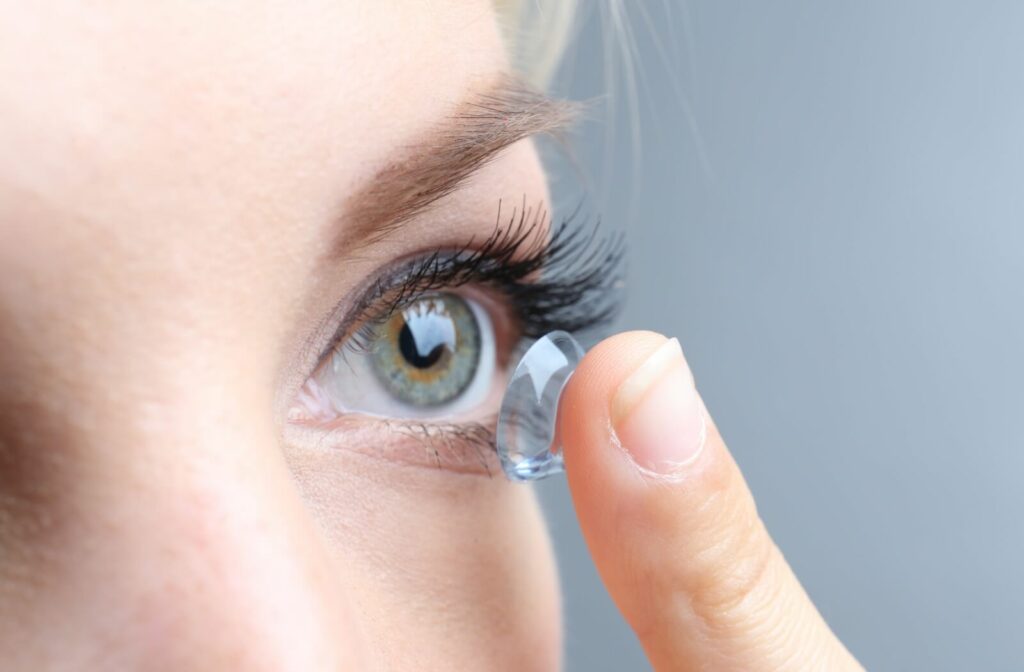Blurry vision is something we all want to avoid. While eyeglasses can often help, some people just don’t like to wear them. When that’s the case, contact lenses are an excellent choice. But contacts aren’t just about replacing glasses—with specialty options like multifocal contact lenses, you can get clear vision while treating conditions like myopia and presbyopia. But how do multifocal lenses work?
Multifocal contact lenses have several prescriptions built into a single lens, each with its own viewing zone. When you look through different zones, your vision is corrected at a different distance—usually nearby, intermediate, and far.
What Are Multifocal Contact Lenses?
When you’re using a regular pair of eyeglasses or contact lenses, your vision is being corrected to appear clear at every distance. The clear materials change how light enters the eye to accommodate your natural refractive error and give you clear vision. With conditions like nearsightedness, your vision is corrected for distance; with farsightedness, it’s the reverse.
But what if your vision problem is a little more complicated? With conditions like presbyopia—a common age-related change in the eye—your eye loses the ability to clearly focus on nearby objects. Your natural lens is no longer as flexible as when you were younger, so the eye struggles to clearly switch to nearby focus.
Presbyopia often causes:
- Difficulty reading small print without holding it further away
- Eye strain or headaches after doing close work or reading
- Difficulty seeing up close in low light conditions
- Squinting or having trouble recognizing faces from a short distance
Presbyopia can be a little more difficult to treat with regular eyeglasses or contacts. This is when specialty contacts like multifocals become an excellent choice.
They’re a certain type of specialty lens that aims to correct conditions like presbyopia. There are several prescriptions built into one lens to accommodate your vision problems; this way, you can fix your nearby vision, intermediate vision, and distant vision all at once.
Multifocal Lenses for Myopia Control
However, it’s not just about presbyopia. “Multifocal” refers to any lens that has more than 2 prescriptions built into the lens. Alongside presbyopia treatment, multifocal lenses have become a popular way to help with myopia control in children.
Myopia, or nearsightedness, is a progressive refractive error that causes the eye to grow too long. This leads to blurry vision when you’re trying to focus on anything more than a few feet away. While eyeglasses can help treat this condition, myopia control is becoming more popular; by intervening early on while the eye is growing, myopia progression can be significantly slowed. And one way this is done is through multifocal lenses.
These lenses can do 2 tasks at once: they provide clear vision and distribute light so it reaches another part of the eye simultaneously. This helps to send signals to the eye that it doesn’t need to grow as much. While it won’t cure myopia, using multifocal lenses for myopia control can significantly slow its progression.
Are There Different Types of Multifocal Contacts?
When it comes to multifocals, there are several different types and shapes. Each is designed with a different purpose in mind. The 3 primary types are:
- Aspheric lenses
- Concentric lenses
- Segmented lenses
Aspheric Contact Lenses
The aspheric design has varying focal lengths that gradually shift from the center to the periphery of the lens, diminishing the power changes to produce a more natural vision transition. This subtle approach offers a more natural viewing experience; rather than having clearly divisible viewing zones, the lens simply offers a smooth transition between powers to give clear vision.
Concentric Contact Lenses
Imagine a set of rings, like that on a bullseye. This is called a concentric pattern, and these lenses follow said pattern. Each ring has a prescription—often staggered between near and distant vision—to offer contrast and focus to the wearer.
This is often used for myopia control. Roughly half of the rings offer clear vision, while the others alter how light enters the eye to help slow myopia progression.
Segmented Contact Lenses
Think of this design like a pair of bifocals or trifocals, though significantly less bulky. Instead of transitioning between zones, a segmented lens has specific zones for specific distances.
Usually:
- The upper segment is for distant vision
- The central area is for intermediate vision
- The lower segment is for near vision
Since each segment addresses specific visual fields, this pattern helps to offer a smooth transition and clear focus without the need to shift your gaze significantly.
Should You Try Multifocal Contact Lenses?
Multifocal contact lenses are a versatile approach to treating plenty of different potential problems. If you’re interested in discussing multifocals or have anything unusual going on with your vision or eyes, come talk to our team at Fontana Optometric Group! We can check your eyes and determine whether or not multifocals are the right answer for you. You deserve clear vision, so book an appointment with our team today.


